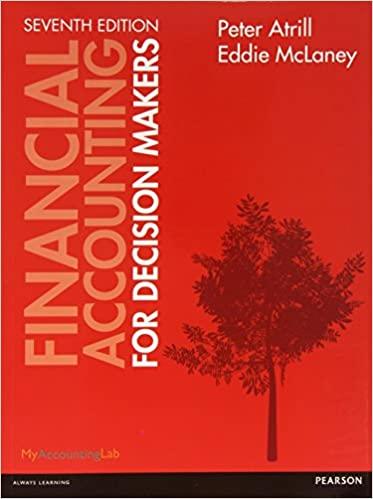Answered step by step
Verified Expert Solution
Question
1 Approved Answer
You have just been hired as a loan officer at Westmount Bank. Your supervisor has given you a file containing a request from Hill Company,
You have just been hired as a loan officer at Westmount Bank. Your supervisor has given you a file containing a request from Hill Company, a manufacturer of computer components, for a $ fiveyear loan. Financial statement data on the company for the past two years are given below:
HILL COMPANY
Comparative Balance Sheet
This Year Last Year
Assets
Current assets:
Cash $ $
Temporary investments
Accounts receivable, net
Inventory
Prepaid expenses
Total current assets
Plant and equipment, net
Total assets $ $
Liabilities and Shareholders' Equity
Liabilities:
Current liabilities $ $
Bonds payable,
Total liabilities
Shareholders' equity:
Preferred shares, $ no par value
Common shares,
Retained earnings
Total shareholders equity
Total liabilities and shareholders' equity $ $
HILL COMPANY
Comparative Income Statement and
Reconciliation of Retained Earnings
This Year Last Year
Sales all on account $ $
Cost of goods sold
Gross margin
Selling and administrative expenses
Operating income
Interest expense
Net income before taxes
Income taxes
Net income
Dividends paid:
Preferred shares
Common shares
Total dividends paid
Net income retained
Retained earnings, beginning of year
Retained earnings, end of year $ $
Pat Smith, who just three years ago was appointed president of Hill Company, admits that the company has been inconsistent in its performance over the past several years. But Smith argues that the company has its costs under control and is now experiencing strong sales growth, as evidenced by the more than increase in sales over the past year. Smith also argues that investors have recognized the improving situation at Hill Company, as shown by the jump in the price of its common shares from $ per share last year to $ per share this year. Smith believes that with strong leadership and with the modernized equipment that the $ loan will permit the company to buy, profits will be even stronger in the future.
Anxious to impress your supervisor, you decide to generate all the information you can about the company. You determine that the following ratios are typical of companies in Hill Companys industry:
Current ratio
Acidtest ratio
Average collection period days
Average sale period days
Return on assets
Debttoequity ratio
Times interest earned ratio
Priceearnings ratio
Required:
You decide to assess the rate of return that the company is generating first.
a Compute the return on total assets for both this year and last year. Total assets at the beginning of last year were $Round your answers to decimal place.
b Compute the return on common shareholders equity for both this year and last year. Shareholders equity at the beginning of last year totalled $ There has been no change in preferred or common shares over the past two years.Round your answers to decimal place.
c Is the companys financial leverage positive or negative?
c This part of the question is not part of your Connect assignment.
You decide to assess how well the company is doing from the perspective of the common shareholders next. For both this year and last year, compute
a The earnings per share. Round your answers to decimal places.
b The dividend yield ratio for common shares. Round your intermediate calculations and final answers to decimal place.
c The dividend payout ratio for common shares. Round your intermediate calculations and final answers to decimal place.
d The priceearnings ratio. Round your intermediate calculations and final answers to decimal place.
d This part of the question is not part of your Connect assignment.
e The book value per common share. Round your answers to decimal places.
e This part of the question is not part of your Connect assignment.
f The gross margin percentage. Round your answers to decimal place.
You decide, finally, to assess creditor ratios to determine both shortte
Step by Step Solution
There are 3 Steps involved in it
Step: 1

Get Instant Access to Expert-Tailored Solutions
See step-by-step solutions with expert insights and AI powered tools for academic success
Step: 2

Step: 3

Ace Your Homework with AI
Get the answers you need in no time with our AI-driven, step-by-step assistance
Get Started


